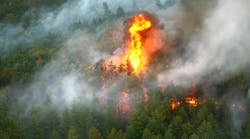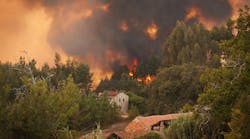If regulators wish to support utility VM then it is essential that they understand how the VM workload expands, why that is so, and the connection to tree-related outage frequency. This is a broad and somewhat complex topic, which I have written about extensively. I will direct the reader to and make reference to these works. I will be presenting a point of view, which you have not likely encountered before. This view is, however, both logically justified and corroborated by an illustrative case study. In other words, please follow the links provided and read the articles, for two reasons: without doing so it will be unlikely that your understanding of utility VM will be advanced and secondly, without reading my rationale, I will come off as a wild-eyed radical.
My major treatise, which has appeared in various publications over the years, is Vegetation Management Concepts and Principles. As I was told by a senior VP at Indianapolis Power & Light, it will allow you to understand why tree-related outages tend to be a cyclically recurring issue. Last year I wrote a series of articles intended to help utility VM professionals to justify VM program funding: VM Funding, VM Funding – Getting it Right, VM Funding - Barriers. I’ll just touch on the main messages here, which are extracted from this series of articles.
Is there a specific annual amount that needs to be spent on VM?
My answer is yes. If you would like to have a sustainable least-cost VM program that simultaneously minimizes tree-related outages, there is a specific minimum that needs to be invested annually in the VM program.
Arriving at this conclusion is facilitated by thinking in terms of the utility forest. Annual changes in a forest are biomass additions and losses. For the utility forest the primary drivers of VM workload are tree growth and tree mortality. Consequently, the expansion of that workload can be defined by a logistic curve.
In forestry terms, the annual addition of biomass is referred to as the annual volume increment (AVI). For the utility forest, the focus being the protection of utility assets, the AVI is composed not only of the biomass additions but also the trees that have become decadent and need to be assessed and pruned or removed to eliminate the hazard. VM funding adequate to remove the AVI holds the system in equilibrium. It is the equivalent of paying the interest accrued on a debt over the year. The following year is begun with the same amount of debt, and assuming no change in the interest rate, the interest that accrues over the following year will be the same.
If funding that permits removal of the AVI provides the least-cost VM program, then any deferred VM cannot be least-cost (see the logistic curve above). Understanding that the VM workload can be described by a logistic curve, leads to the conclusion that the deferred workload will expand exponentially.
If we are to take this beyond a conceptual understanding, we need to quantify the AVI value. Doing so requires identifying the area or number of each work type and the average maintenance cycle for each. Determining the maintenance cycle requires quantifying tree/brush growth and re-growth rates.
We need also look at what work lies outside the right of way. This will involve some pruning. Also by far, the majority of hazard tree removal work will originate outside the right of way. From work done examining the extent of natural tree mortality, I believe we as an industry have generally underestimated this aspect of the work. Consequently, I would recommend against using historical spending in the determination of the AVI unless the utility can show that tree-related outages have been level over the last 10 to 20 years. Rather, total danger tree exposure should be determined and local annual tree mortality rates applied to that population.
Does the AVI change?
There is an upward shift in the AVI over time as trees adjacent to power lines grow taller, increasing the size of the utility forest and thereby, the amount of hazard tree work.
An extended period of higher than normal moisture or drought or the introduction of a new pest can have a major impact, changing the balance and the AVI for years.
From VM Funding – Barriers:
How many utilities are currently using this approach? How many have used it to justify VM funding requirements to their regulators? A good number have used a tree and brush inventory and growth rates to explain funding needs. However, in many cases the resulting VM programs have become victims of their own success. As tree-related outages drop dramatically it becomes exceedingly difficult to justify continued spending to regulators or oversight bodies. If management has not already withdrawn their support for what they perceive to be an ongoing high level of expenditures, the support is typically withdrawn once the regulator points out that the motivation, a high incidence of tree-related outages, no longer exists. Recognizing that VM workload can be represented by a logistic curve and the derivative, the concept of the need to remove as a minimum the AVI, is the antidote because it makes apparent the financial risk associated with underfunding.
… there are some points of resistance to having actual tree and brush conditions drive the funding. One is senior utility management. VM is typically within the top three O & M expenditures for distribution systems. At most utilities, VM work is contracted out. Consequently, VM represents a large pool of money that offers the flexibility of re-distribution in hard financial times, without having to reduce utility staff. By separating VM out from O & M funds to obtain regulatory approval for specific, dedicated funding, management loses flexibility. Of course, maintaining budgetary flexibility by not making VM a separate regulatory issue ignores the risk that tree-related outages may increase, drawing public, political and regulator attention. However, the thinking during tough financial times appears to be: we’ll deal with that issue when it arises.
Another barrier to proper VM funding is the regulatory process. The regulator’s role is to protect the consumer. That means regulators will naturally be resistant to any request for increased VM funding. Their resistance is bolstered by consumer advocates and other interveners, none of whom want to see electric rates increase. To justify funding the utility needs to specify the benefit associated with increased funding or the risks that are likely to be realized in the absence of that funding. This may temporarily set the VM program on the proper foundation. However, the regulatory process is biased against long-term proper funding because to sustain the proper level of funding the utility would need to prove harm or negative events that would have occurred but for the proper funding.
Yes, you read that right. Yes it defies logic. It’s simply a perverse consequence of the adversarial regulatory process. I’m not saying I know a better way; just recognizing what is an inherent trait in the process.
In Part 5 we will discuss reliability to make explicit what VM operations and actions hold the potential to reduce tree-related outages during normal operating conditions and during major storms.

